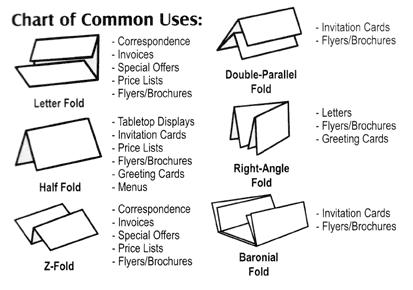|
Hand-folding letters is time consuming and costly. Automatic paper folders, however, produce a clean, straight fold in merely seconds. The standard fold styles offered by most manufacturers are the single, letter, double parallel and accordion. Most standard fold styles can be used with a #10 sized business envelopes. If you need to make custom folds, you may want to consider models that allow users to manually set the folds by adjusting the fold plate. Many paper folders designed for medium to high volume folding allow users to pre-program specialized folds for future use. The fold plates on these machines can be adjusted in one of three ways. Manually folding is efficient for low to medium volume folding. A semi-automatic folder is ideal for medium volume. For high volume use, the best folder choice would be a programmable automatic folder. The fold plates on semi-automatic folders are adjusted with a dial, while manual folders feature hand-adjusted fold plates. Use a programmable paper folder for accurate folding at the touch of a button.

Some of the most popular fold styles are:
- single fold (half-fold)
- letter fold (C-fold)
- accordion fold (Z-fold)
- half-accordion fold (engineering-fold) (fold out)
- double parallel
- brochure fold (gate-fold)
- right angle fold
Single Fold
Paper is folded into two equal parts with a single fold. Can be used to create 4 separate panels/pages to be printed upon.
Used For: bulletins, menus, programs, greeting cards, wine lists, technical instructions, booklet pages.
Letter Fold
Paper is folded using two folds. The sheet is folded into three nearly equal sections, with one panel serving as the cover. This format is mostly used for self-mailing brochures or pamphlets as it creates 6 full panels that can be used for printed content.
Used For: letters, statements, invoices, bulletins, any letter size sheet (8.5" x 11") requiring insertion into a standard #10 or #9 envelope.
Accordion Fold
Paper is folded in a fashion similar to that of the letter fold with sections the same size. Two folds create two outer panels folded in over the third center panel.
Used For: brochures, letters, statements, proposals, purchase orders, anything requiring insertion into a standard #10 or #9 envelope.
Double Parallel Fold
This type of fold is also referred to as an 8-sheet fold. The paper is folded in half and then in half again using 2 parallel folds. This process creates 4 panels. Folding a legal size sheet (8.5" x 14") in this manner will allow it to fit into a standard #10/#9 envelope.
Used For: self-mailers, newsletters, brochures, letters, statements, proposals, purchase orders.
Engineering fold/fold-out
This type of fold is typically used for ledger size sheets (11" x 17") that are bound in proposals or technical documents. The paper is folded just off-center then the larger panel is folded in half on itself. The narrowest panel can be pulled out to expand the sheet to its full width, while the left edge is free to be bound in a book or binder.
Used For: proposals and technical documents
Brochure Fold
The paper is folded into two equal wing panels that close together like a gate over the larger center panel using two parallel folds.
|